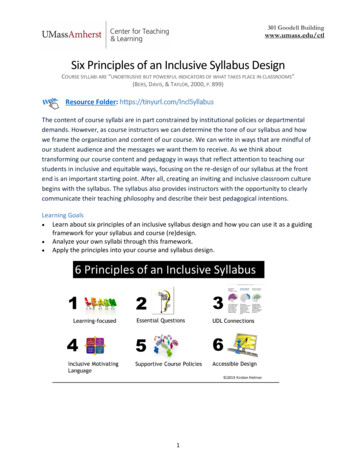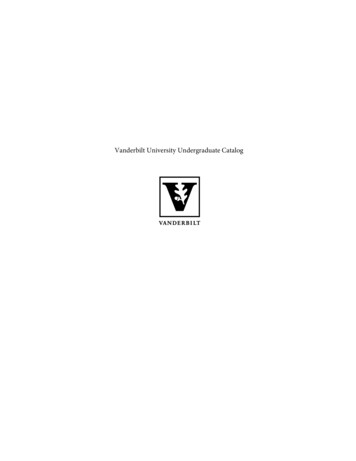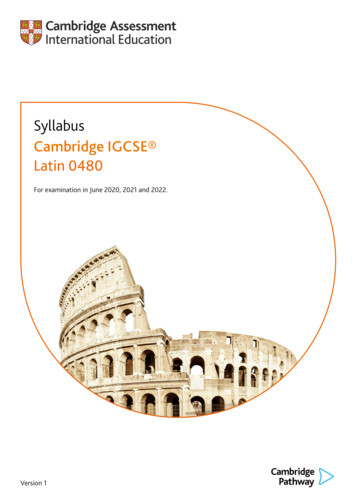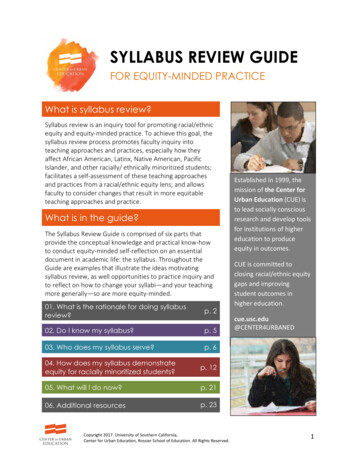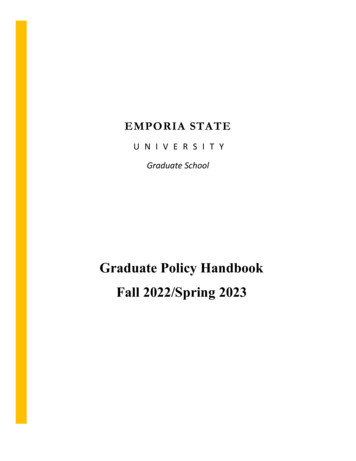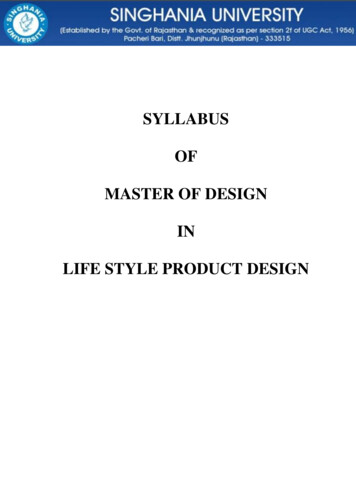
Transcription
SYLLABUSOFMASTER OF DESIGNINLIFE STYLE PRODUCT DESIGN
TEXTILE STUDIESOBJECTIVE:The subject aims to make the students differentiate types of fabrics and yarns and the use of it in clothing.UNIT – 1: TEXTILE FIBERSFlow chart from fiber to finished fabric -Fiber classification Different methods of fiber identification – physicalexamination, burning test, chemical test. Properties of natural fibers (vegetables and animal) i.e. cotton, linen, wool,silk, etc. - Properties of Synthetic fibers i.e. Polyester, nylon, acrylic, etc.UNIT – 2: YARNDifferent yarn formation process i.e. cotton yarn, woolen / worsted yarn, synthetic or blended yarn – blending, opening,cleaning, doubling, carding, combing, drawing, roving, spinning, yarn twist – S and Z. Different types of yarns -Fiberquality requirements for different types of yarn and fabrics. -Different methods of fabric formation i.e. Weaving,Knitting, non- woven. -Comparative study of woven, knitted and non- woven fabrics.UNIT – 3: WEAVINGDifferent types of weaves – plain, satin, sateen, twill, bird‟s eye, jacquard, basket, ribbed, crepe, pile, dobby, tri-axial,lappet. -Properties and uses of different weaves. -Construction of different weaves – their EPI and PPI. Different typesof Weaving machinery, i.e. dobby, jacquard.Common defects in weaving.UNIT – 4: WOVEN FABRICWoven -Classification of woven -Properties and end users of woven -Different methods of production – Webformation, bonding, finishing, and fusing.UNIT – 5: NON-WOWEN FABRICClassification of non-woven fabric- different formation – properties of non-woven-different methods andfinishing.-Gain complete knowledge about the fabric and yarn structure, weavingREFERENCE BOOKS:Textiles – Fiber to Fabric by Bernard P. Corbman McGraw HillIntroduction to textiles by KVP Singh Kalyani PublishersTextiles – Fiber to Fabric by Bernard P. CorbmanMc Gram Hill4 Textiles fabric & Their Selection, Wingate, I.B. Allied Publications Pvt. Ltd., Chennai.Fundamentals of Textiles and Their care. Dantyagi.S. Orient Longman Ltd., New Delhi 198B
TEXTILE DESIGN & COLOUROBJECTIVE:The course aims to enhance the drawing skills of the learner in terms of space, proportion, colour thus evolving into adesign and dyes)UNIT – 1: BASIC - DRAWINGExploration of the various characteristics of line and its expression. Horizontal, Vertical, diagonal, thick, thin, wavy, straightand zigzag. Exploration of the various types of shapes line squares, rectangles, triangles, circles, polygons etc., and formslike cubes, cones, prisms, spheres, cylinders etc. Study of light and dark, illusions of depth, advancing forms, etc.Experimentation with textural effects- visual and tactile, natural and man-made like cross hatching, dots, squares, stripes etc.The physical properties of colour, the psychological impact, the various harmonies, their permutations and combinations.UNIT – 2: DRAWING AND ILLUSTRATIONAerial space, linear space, planar space, receding space, advancing space etc., Designing a unit and its application.Symmetrical balance, asymmetrical balance, radical balance using the various elements of design. Interrelated proportions,contrasting and relating scales using the elements of design. Repetitive rhythm, progressive rhythm, radial rhythm,alternating rhythm. Principle of subordination and domination and highlighting / underplaying. Combination of the elementsof design in an integrated manner. Integration of diverse features unifying elements. Stimulation of interest in compositionsmade for similar features with the introduction of varied elements.UNIT – 3: COLOURDimensions of color- hue, intensity and value. Color wheel and its various color schemes- primary, secondary, tertiary,quaternary, warm and cool colours, Analogous colours, complimentary and split complimentary, tints, tones and shades ,achromatic and monochromatic colours, pastels and dusty pastels- effect of these colour schemes. Effects of colours- red,blue, green, yellow, orange, pink, purple, grey black, white, neutrals.Colour and combination in clothes. Factors affecting thechoice of colours- effects of light, texture, age, size, personality, complexion, occasion. Natural Dyes – synthetic dyes –Types of Dyes preparation – Dyeing method.UNIT – 4: TEXTURETypes of textures- thread pulling, thread crumple, thread rolling, paper dabbling, wax rubbing, wax drop , smoke , blade ,leaf, flower, butterfly, lace, jute, thumb, matchstick, sponge, cabbage, potato, onion, chilly, lady finger, ink drop, ink blow,drop ink, batik, leather, dry brush, mesh, comb, cloth dabbling etc., Textural effects, use of textures in fashion designing.Depicting textures (e.g., silk, satin, chiffon, denim, corduroy, velvet, knit etc., ) and patterns on clothes.UNIT – 5: DESIGNPrinciples of design-repetition, gradation, radiation, dominance, unity, harmony, contrast, Proportion, balance & rhythm- itsimportance in designing. Elements of Design-Lines, Dots, Prints, Checks, silhouettes, colour, texture, etc.TEXT BOOK:DESIGN STUDIES by ManmeetSodhia- Kalyani Publishers
REFERENCE BOOK:Fashion and color by Mary Garthe- Rockport PublishersColor Harmony2 by Bride M.Whelan- Rockport PublishersAPPAREL FASHION DESIGNUNIT ITerms related to the fashion industry –fashion, style, fad, classic, and collection, chic Custom made , mannequin ,fashion , show, trend, forecasting, high fashion, fashion cycle, haute couture, couture, couturier, fashion director,fashion editor, line, knock-off avant garde, bridge, buying house, apparel, fashion merchandising, pre –a –porter,sample.UNIT IIElements of design –line, shape or form, colour , size and texture. Application of structural and decorative design in adress, selection and application of trimmings and decorations. Principles of design -balance –formal and informal,rhythm-through repetition, radiation and gradation, emphasis, harmony and proportion. Application of principles ofdesign in a dress. Design-definition and types–structural and decorative design, requirements of a good structural anddecorative design. Colour-definition, colour theories-prang colour chart and munsell colour system, Dimensions ofcolour-hue, value, and intensity. Standard colour harmonies-application in dress designUNIT IIIWardrobe planning for different age groups, factors influencing wardrobe selection, Fashion and season, Designingdresses for different occasions –business meetings, parties/ dinners, evenings/leisure hours, marriage functions, sports,uniforms for civil service, airhostess, hoteliers, schools –girls and boys (school, high school).UNIT IVDeigning dresses for unusual figures –becoming and unbecoming –for the following figure types. Stout figure, thinfigure, slender figure, narrow shoulders, broad shoulders, round shoulders, large bust, flat chest, large hip, largeabdomen, round face, large face, small face, prominent chin and jaw, prominent forehead.UNIT VStudy of Indian designers – Tamil Nadu, Maharashtra, Rajasthan, Karnataka and Uttar Pradesh and World designers –France, Germany, U.S, United Kingdom and Italy (any one popular designer)REFERENCES:Fashion Sketch Book –Bina Abling, Fair Child Publications, New York Wardrobe.Strategies for Women –Judith Rasband, Delmar publishers London.Inside the Fashion Business- Bennett,Coleman & Co,Mumbai,1998.Art and Fashion in clothing selection – Harriet T,Mc Jimsey,The Iowa University press,Ames,Iowa.1973.Fashion – from concept to consumer – Gini Stephens Frings,6th Edition,prentics Hall(1999).
LEATHER PRODUCT DESIGNOBJECTIVE: The course aims to make the student understand the methods of processing and dying leather to be usedas dress, as accessories which are also a thriving market on its own.UNIT-1: INTRODUCTION TO LEATHERHistory of leather- classification of leather- leather structure- leather science- leather processing- leather tanneryleather printing- classification of leather varieties- blue leather- leather board.UNIT-2: LEATHER PROCESSLeather dyes- method of dying- suitability of dyes- process involved- tannery process- leather finishing processimportant process involved- quality control of leather- TQM- industry- industrial safety- classification of adhesivesmethod of adhesive selection- later adhesive- Neoprene adhesive- polyurethane adhesives- hot melt adhesives- pressuresensitive adhesiveUNIT- 3: LEATHER GOODS DESIGNLeather goods illustration drawing- line drawing- pattern design- sketch drawing- measurement of leader goodspattern making- elements of tools and equipment’s- varieties key hook purse- coin purse- gents purse- ladies pursegents wallet- gents wash belt- travel bag- gents pouch – gents bag- ladies- brief case- bag holder- document file- cashbox- VIP- file cover- industrial belt- industrial gloves- fancy gloves- optical glass cover.UNIT – 4: LEATHER FOOTWEAR DESIGNFoot wear illustration drawing- pattern design- pattern making- elements of tools and equipments- footwear designfootwear styles- sports and athletic- footwear modeling- design and footwear industry- safety shoes- orthopedicfootwear- anatomy of human foot- skeletal structures of foot- muscle of fasica- structural and durable- stabilitycontribution of bones and muscles for stability in both static and dynamic postures- foot abnormalities an introductionchildren‟s foot wear- men‟s wear- woman‟s footwear- seasonal footwear- seasonal shoes- sportswear- modern andfashion foot wears.UNIT – 5: LEATHER FASHION GARMENT DESIGNLine drawing- illustration drawing- figure drawing- 8 head theory- design drawing- classification of garment designclassification of children women men garments pattern making- industrial pattern design and grading- sportswearjacket- classification of fashion accuracy design- drawing equipments and tools- pattern tools, garment industryequipments- finishing process.OUTCOME: The Students will gain knowledge about the leather processing, leather goods, leather foot ware andLeather Garments.TEXT BOOKS:1. Inside fashion business by Dickerson -Pearson2. Inside fashion business by Tate -PearsonREFERENCE BOOKS:1. Footwear manufacture- Thomton.h2. Pattern making manual- women garments, esmod, paris3. Skiving manual- CLRI madras
4. Fashion design modeling- alt Bangalore5. Adhesive in shoe manufacture- VendatappiahTEXTILE DESIGN, COLOUR RENDERING & COMPUTER SOFTWARE1. Draw a Nature study of Birds, Animal forms Trees.2. Draw a Fruits, Vegetables, flowers and geometrical forms.3. Prepare exercises in lettering various types of Lines, rounds, zigzag, thin and thick.4. Prepare a Textile Block printing designs on paper (8” x9” or 9” X 12”)5. Prepare a two colour dress material textile designs, size- 9x9 inches .6. Draw a COLOR WHEEL and warm and cool colours ,7. Draw analogous colours- tints, tones and shades, achromatic and monochromatic colours .8. Draw effects of colors- red, blue, green, yellow, orange, pink, purple, grey black, white, neutrals.9. Draw two colour dress material textile natural design, size – 9x9 inches using coral draw software.10. Draw two colour dress material textile abstract design, size – 9x9 inches using coral draw software.11. Draw two colour dress material textile Geometrical design, size – 9x9 inches using coral draw software.12. Do colour separation in given dress material design by coral draw.13. Separate first colour and second colour of given design by film processing coral draw14. Prepare a sari border design15. Prepare a sari pallu design16. Prepare sari border and pallu design with two colours and four colours17. Prepare colour preparation, colour correction, & colour matching.18. Draw any traditional textile sari design with multicolours19. Do traditional printing like batik, hand block printing, dye & tie
FASHION SKETCHING & ILLUSTRATIONFASHION SKETCHING1. Draw a croqui drawing – all sizes, and all poses (front,back,side,3/4)2. Draw a different types of Faces ; Hands, eyes, nose, lips, ear.3. Draw Hair styles4. Draw Illustration of Gathers, Folds, Pleats showing fullness in a garment.5. Draw an illustration drawing and figure drawing6. Prepare collage work of different models7. Draw in detail- Collars, Necklines, Pockets, Sleeves, Waistlines, cuffs, skirts, trousers, yokes, waistlinesFASHION ILLUSTRATION1. Figure drawing2. Different types of apparels3. Different styles of garmentsPrepare different presentation of fashion illustration1. Water colour2. Poster colour3. Colour pencil4. Collage workDraw classic and innovative designs1. Collars2. Necklines3. Pockets4. Sleeves5. Waistlines. Cuffs, skirts,6. Trousers, yokes, waistlines
LEATHER GOODS, FOOTWEAR & GARMENTS DRAWING1. Draw leather goods- key chain, valet, hand glove types of bags , belt, leather ornaments, briefcase , suitcase2. Prepare drafting and pattern making leather goods3. Prepare leather goods finishing process(cutting, stitching, adhesives, and moulding)4. Draw leather footwear design ( types of slipper, shoes, sports & industrial safety shoes)5. Prepare pattern making footwear (different types)6. Prepare upper clicking and closing methods7. Bottom making and finishing process8. Draw different types of leather fashion garments9. Prepare pattern making, cutting and stitching process
HISTORY OF JEWELRY AND ARTOBJECTIVES:The objective of this course is to impart knowledge of the History and importance of Jewelry from ancient times.Unit 1 History of Art and JewelryIntroduction to art and ornament, The ancient world, The middle age / masterpiece of middle age, Materials used injewelry and ancient methods, Baroque to revolutionUnit 2 Jewelry Eras from 18th& 19the century Great BritainGeorgian era jewelry (1714 to 1830, Victorian era jewelry (1837 to 1901).mid and late Victorian period, Edwardianperiod jewelry, La Belle époque jewelry (1895 to 1914)Unit 3 Art NouveauOrigins, Form and character, Relationship with contemporary style and movements, Sculpture and jewelryUnit 4 Art Deco or style modernEtymology, origins and history, Art deco characteristics and materials, Retro, Influence.Unit 5 Indian jewelry & JBI (Jewelry business in India)History of Indian jewelry (The origin and growth of jewelry in India), Types of Indian Jewelry, A historic recount ofMughal jewelry, Significances of Indian jewelry, Tribal Jewelry.Identification of ancient jewelry using Sanskrit, Hindi & other metallic coins and their trend, Specialty in ornamentsworn by people in different state and region, Importance of jewelry – Currency, Functional use, Symbolism, Protection,Artistic Display and Personal Expression. Modern trends in jewelry designs in India, Application of knowledge onancient Indian jewelry to design modern jewelry.References Books1. Jewelry of India by Chaturvedi.2. Jewelry and personal adornment by Kamala Dong.3. Traditional jewelry by Oppi Untracht.
GEMOLOGYObjectives:To understand the origin, and physical structure and properties of natural gem material.To understand the working and construction of various lab equipments and their use.To be able to identify natural and artificial gem materials.To be able to grade the natural gem material.Unit I : Internal features of gemstonesTypes of natural inclusionTypes of manmade inclusions and signs of enhancement treatments on gemstonesTypes of blemishes, surface irregularities of gemstonesColor zoningUnit II : Optical PropertiesNature of light : The electromagnetic spectrumReflection : Laws of reflection, importance in gemologyRefraction : Laws of refraction, refractive index,Total internal reflectionPolarized light : nature and production of polarized light,Luster, sheen, chatoyancy and asterism in gemstones.Isotropism and Anisotropism in gemstones,Anomalous double refractionOptic axes of gemstonesUnit III : Equipments based on optical properties of gemstones and their useRefractometerDesign and construction of refractometerMeasurement of R.I.Birefringence by refractometerPolariscopeDesign and construction of polariscopeApplication of polariscope in gemologyDichroscope; construction and useSpectroscope ; construction and useMicroscope ; construction and useUltra violet light and x-rays and their application in gemology; luminescenceUse of chelsa filter10x lensUnit IV : Nature of colourAbsorption of light, differential absorption of lightAllochromatism, idiochromatism in gemstones
PlechorismAbsorbtion spectraInterference and differaction,Play of colors ; dispersion, metamerismBASIC TECHNIQUES IN JEWELRY DESIGNOBJECTIVES:The aim of this course is to impart knowledge on alternative materials and the techniques that can be used to createJewelry.1. IntroductionHistorical perspective, usage of experimental jewelry, Designers creating experimental jewelry, Researching themesand ideas, Design considerations, techniques2. MaterialsPlastic and acrylic, glass, fabric, paper, wood, new age/organic materials- resins, unusual metals, fibres, leather etc.3. TechniquesPlastic and acrylic- joining mechanisms, colouring, shaping and moulding etc, glass- blowing colouring, designpossibilities, Fabric – pleating, stitching, braiding etc, Paper- folding, paper Mache, joining mechanisms, Wood –carving, drilling, shaping etc, other techniques used as per materials4. Designing Experimental JewelrySelecting a theme/ material for experimentation, understanding and exploring possibilities in chosen materials,combining traditional jewelry techniques with experimental material, design developments, exploring end users andsale points, showcasing experimental jewelry
GEMOLOGY [PRACTICAL]Objectives:To understand the origin, and physical structure and properties of natural gem material.To understand the working and construction of various lab equipments and their use.To be able to identify natural and artificial gem materials.To be able to grade the natural gem material.Practical1. Study of crystal forms, habits, and growth features of various gemstones2. Learn to handle 10x lens, microscope, and other lab equipments.3. Drawings of various types of gemstone cuts and colors.4. Identification of real gemstones and artificial one5. Study of various treatments done on gemstones and their testing using lab equipments6. Grading of gemstones.References:1. Gemstones – Cally Oldershaw2. Gemmology – Peter G. Read3. Gestores of the world – Revised edition walter schumann4. Gem indentification made easy – Matlins and Bonanno
SKETCHING AND RENDERING - IOBJECTIVES:To provide opportunity for skill development in sketching accessories.To impart knowledge on fashion accessories and creativity. SOL (Specific Objective Learning):The provide opportunity for skill development in sketching accessories.Impart knowledge on fashion accessories and creativity.UNIT- IIdentify basic design styles. Rendering Techniques - Pencil, Steadler and Color Pencil, Charcoal. Fabric RenderingSamples of Different Varieties of Fabric. Drawing Accessories on different surfaces 2Dimensional drawing ofaccessories – drawing using dimensions and measurements 3Dimensional drawing of accessories – drawing differentperspectivesUNIT-IIUse template to draw sketches Perform rendering Obtaining and observing drawing for rendering operationIdentification and selection of appropriate rendering techniques- Spraying, Brushing Rendering mediums- Water color,Pencil color and Oil color Creating components using rendering techniques and mediums –Texture, Volume, Light andshade effects Draw and render materials and accessories – fittings & fastenersUNIT- IIIDrawing of Footwear Men’s – Casual Shoes, formal shoes, flip-flops, sandals, sports shoes, boots. Women’s – Boots,Floaters, gladiators, mojaris, heels, wedges, sandals, bellies, flip flops Children – Shoes, flip-flop’s, sandalsUNIT-IVDrawing men’s accessories: Wallets, Belts, suspenders, socks, card holders, key chains, hats 7 caps, head wraps,necktie, cufflinks, cravats, handkerchiefs, pocket squares, muffler, umbrella, stoles and scarves. Drawing women’saccessories: Wallets, Belts, socks & stockings, suspenders, neckties, hair accessories, mufflers, hats & caps, headwraps, cufflinks, umbrellas, cravats, handkerchiefs, stoles & scarvesUNIT-VDrawing bags Travel bags, Ladies hand bagsREFERENCES1. “Quick style”, by- Christine Kunzerlman.2. 1000 Ideas by fashion designers Carolina Cerime3. 150 Beaded & motifs Kenneth D King4. 21st Century Jewelry Mrthe Le Van5. Accessories options : Shrugs scaxues stoles6. Bead Fantasies 2 – More beautiful easy to make jeweler Takako Sanejima
ELEMENTS AND METHODOLOGY OF DESIGNSObjectives:To make the students understand about elements and methodology of designs.To enable the students to gain knowledge on elements and methodology of designsThe students understand about elements and methodology of designs.The students to gain knowledge on elements and methodology of designs5. Create compositions using elements and basic design principlesElements of designs- Line, Shape, Point and FormBasic principles of design and visual aesthetics- Balance, Rhythm, Contrast and HarmonyDeveloping compositions using design elements- Centered, Spaced, Shattered and FramedDepicting moods through basic elements of design- Masculine and Feminine2. Identify color as an element of designDimensions of color- Value/tone, Hue and Chroma/intensity/clarityMixing colors to create new combinations or schemes – Primary, Secondary and TertiaryShade scale preparation according to color mixing principlesRelationship of color theory to design process identification3. Identify visual effects of colorVisual or optical effects of color – Size, Density, Value, Visual mixing, SimultaneousContrast, Motion, Texture, creating and presenting Fashion pictures that reflect differentVisual effects4. Perform design processConcept of design process – Information collection, Analysis, Synthesis and conceptualizationIdentifying and analyzing Structure and context buildingInfluence of material for effective design processCommercial considerations in producing a designREFERENCES1. “Quick style”, by- Christine Kunzerlman.2. 1000 Ideas by fashion designersCarolina Cerime3. 150 Beaded & motifs Kenneth D King4. 21st Century Jewelry Mrthe Le Van5. Accessories options : Shrugs scaxues stoles6. Bead Fantasies 2 – More beautiful easy to make 14eweller Takako Sanejima
Terms related to the fashion industry -fashion, style, fad, classic, and collection, chic Custom made , mannequin , fashion , show, trend, forecasting, high fashion, fashion cycle, haute couture, couture, couturier, fashion director, . Line drawing- illustration drawing- figure drawing- 8 head theory- design drawing- classification of .




